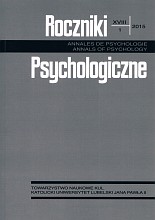Co mierzą narzędzia psychometryczne stosowane w Polsce do diagnozy predyspozycji kierowców? Doniesienie z badań
What is measured by the psychometric tools used for driver aptitude assessment in Poland? A research report
Author(s): Bohdan Rożnowski, Oleg Gorbaniuk, Maria Biela-Warenica, Adam BielaSubject(s): Psychology
Published by: Towarzystwo Naukowe KUL & Katolicki Uniwersytet Lubelski Jana Pawła II
Keywords: transport psychology; diagnostic methods; traffic accident prevention
Summary/Abstract: The safety performance of road drivers requires an improvement of the mechanism of selecting candidates for professional drivers. Unfortunately, it has been common practice until now to design diagnostic methods to reflect the theoretical constructs of traits and abilities considered useful in road traffic. We decided to adopt the opposite, complementary approach and to analyze what the methods used in Polish transport psychology really measure and what theoretical constructs that corresponds to. The results will be treated as a first step towards determining the prognostic validity of these psychometric tools. We tested 300 professional male drivers, aged form 21 to 65 years, belonging to six groups of equal size: victims of collisions, victims of accidents, perpetrators of collisions, perpetrators of accidents, drivers stopped by the police for drunk driving and those who had never been involved in any of the above situations. The analysis concerned 27 indicators taken from nine diagnostic tools commonly used by transport psychologists in Poland. Exploratory factor analysis was performed to determine the latent factor structure of these methods. The Kaiser criterion allowed us to identify the eight-factor solution as the optimal one. The extracted factors are: attention, accuracy in visual perception, mental alertness, sense of community, efficiency of reactiveness and decision making, cognitive abilities (logical induction and grasping analogy), agency, and sensitivity to social approval.
Journal: Roczniki Psychologiczne
- Issue Year: 18/2015
- Issue No: 1
- Page Range: 133-143
- Page Count: 11

